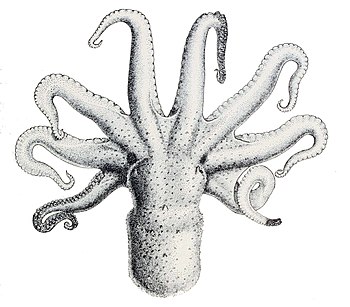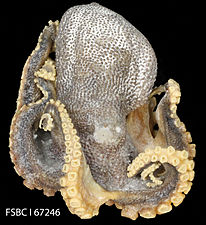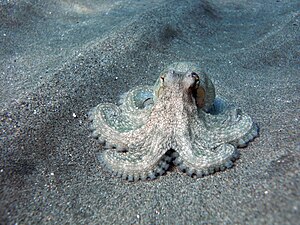Octopuses
| Octopuses | ||||||||||
|---|---|---|---|---|---|---|---|---|---|---|

Profile of a white octopus ( Octopus pallidus ) |
||||||||||
| Systematics | ||||||||||
|
||||||||||
| Scientific name | ||||||||||
| Octopus | ||||||||||
| Cuvier , 1797 |

The octopus or octopus ( Octopus ) form with more than one hundred species, the largest genus within the family of genuine squid .
designation
The Latin word octopus corresponds to the ancient Greek model ὀκτώπους oktṓpous , a combination of oktṓ "eight" and poús ( genitive podós ) for "foot". Octopus literally means "eight feet", which means "animal with eight feet".
The scientific generic name Octopus is written in Latin (with c), otherwise the Germanized spelling with k is also used: octopus . Duden lists both octopuses and octopods as plural forms (see also Kraken # Scientific Name ).
The terms pulp and pulp for the octopus genus Octopus are out of date. Both forms are ultimately variants of the word polyp , which goes back to the Greek polýpous and thus actually means "many feet".
features
Many of the species have not yet been scientifically described. Although the species in the genus share some common characteristics, this genus lacks specific characteristics. The individual species usually only share the name "octopus". Until it is scientifically redefined and rearranged by taxonomists , the present system is still valid. All octopus species have two rows of suction cups on their arms. Anal valves and an ink pouch are provided. Another thing they have in common is that in males the third arm is the hectocotylus .
The size varies greatly between the individual species. Some animals reach lengths of over a meter. The smallest species, the Octopus wolfi , is only 10 cm tall. The coloring is also very different between the individual subspecies.
distribution
The different genera of the family of the real octopus can be found in all oceans of the earth. The wide range of habitats they occupy includes coral reefs , rock reefs, seagrass and algae beds, sand, mud and other soft substrates . Most Octopodidae are basic inhabitants ( Benthal ).
Historical systematics
The genus Octopus was first described in 1784 by the German classical philologist and natural scientist Johann Gottlob Schneider in his collection of mixed treatises for the clarification of zoology and the history of action under the name Octopodia . Since Schneider, in accordance with the practice of the time, capitalized the species suffixes such as polypus and sepia, which are written in small letters today , and referred to the genus as “sex” Octopodia and the species as “classes”, Schneider's species additions were interpreted and used as genera by subsequent zoologists. Schneider's generic name “Octopodia” became the scientific name of the order Kraken as Octopoda and has survived as such to this day. The confusion was heightened by the fact that early in the 20th century some malacologists used the generic name Polypus instead of Octopodia or Octopus .
At the request of the English entomologist Francis Hemming , secretary of the International Commission on Zoological Nomenclature (ICZN) from 1937 to 1958 , the commission dealt with the naming of octopuses. The priority rule , according to Schneider's names would be recognized as valid, since they were first published. However, this would have meant that Octopodia would have resembled the name of the order too closely. In addition, other names have long been used. In 1955 the ICZN suppressed the names given by Schneider in favor of Octopus Cuvier in 1797. This also made Polypus and other generic names invalid, and Octopus the correct name of the genus.
Systematics
Numerous species have been described in the genus Octopus . In this system, only valid species are taken into account, there are also numerous species names that are no longer generally accepted ( taxon inquirendum ).
Individual evidence
- ↑ Duden online: Octopus
- ↑ Brockhaus' Kleines Konversations-Lexikon (1911): Pulp = Seepolyp = the genus Octopus .
- ^ Meyers Großes Konversations-Lexikon (1905): Pulpe = the genus Octopus .
- ↑ See Duden online: Polyp
- ↑ a b c Cephalopods of the world. An annotated and illustrated catalog of cephalopod species known to date (p. 187)
- ↑ a b Robert Nordsieck: Kraken (Octopodidae)
- ↑ a b Octopodidae - Article at Tree of Life
- ↑ Johann Gottlob Schneider : Collection of mixed treatises for the clarification of the zoology and the history of action . Unger, Berlin 1784, doi : 10.5962 / bhl.title.39836 .
- ^ Opinion 233. Suppression, under the Plenary Powers, of the name Octopodia Schneider, 1784 (class Cephalopoda), and of certain reputed names published by the same author in 1784 . In: Francis Hemming (Ed.): Opinions and declarations rendered by the International Commission on Zoological Nomenclature . Volume 4, Part 23. International Commission on Zoological Nomenclature , London April 21, 1954, pp. 275-296 ( digitized version ).






